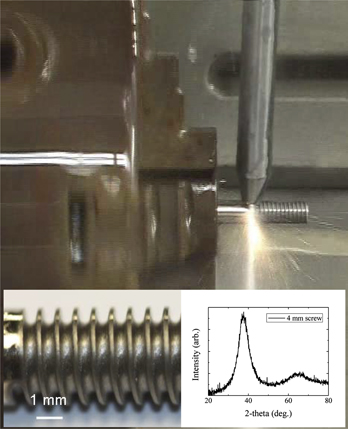Crossref Citations
This article has been cited by the following publications. This list is generated based on data provided by
Crossref.
Saptaji, Kushendarsyah
Gebremariam, Mebrahitom Asmelash
and
Azhari, Mohd Azmir Bin Mohd
2018.
Machining of biocompatible materials: a review.
The International Journal of Advanced Manufacturing Technology,
Vol. 97,
Issue. 5-8,
p.
2255.
Maroju, Naresh Kumar
and
Jin, Xiaoliang
2019.
Mechanism of Chip Segmentation in Orthogonal Cutting of Zr-Based Bulk Metallic Glass.
Journal of Manufacturing Science and Engineering,
Vol. 141,
Issue. 8,
Perec, Andrzej
Pude, Frank
Grigoryev, Anton
Kaufeld, Michael
and
Wegener, Konrad
2019.
A study of wear on focusing tubes exposed to corundum-based abrasives in the waterjet cutting process.
The International Journal of Advanced Manufacturing Technology,
Vol. 104,
Issue. 5-8,
p.
2415.
Radomska-Zalas, A
Perec, A
and
Fajdek-Bieda, A
2019.
IT support for optimisation of abrasive water cutting process using the TOPSIS method.
IOP Conference Series: Materials Science and Engineering,
Vol. 710,
Issue. 1,
p.
012008.
Li, Guangxian
and
Ding, Songlin
2020.
Metallic Biomaterials Processing and Medical Device Manufacturing.
p.
137.
Halim, Qayyum
Mohamed, Nik Abdullah Nik
Rejab, Mohd Ruzaimi Mat
Naim, Wan Naimah Wan Abdul
and
Ma, Quanjin
2021.
Metallic glass properties, processing method and development perspective: a review.
The International Journal of Advanced Manufacturing Technology,
Vol. 112,
Issue. 5-6,
p.
1231.
Perec, Andrzej
and
Musial, Wojciech
2021.
Advances in Manufacturing Engineering and Materials II.
p.
50.
Perec, Andrzej
Radomska-Zalas, Aleksandra
Fajdek-Bieda, Anna
and
Kawecka, Elzbieta
2022.
Efficiency of Tool Steel Cutting by Water Jet with Recycled Abrasive Materials.
Materials,
Vol. 15,
Issue. 11,
p.
3978.
Perec, Andrzej
and
Radomska-Zalas, Aleksandra
2022.
WASPAS Optimization in Advanced Manufacturing.
Procedia Computer Science,
Vol. 207,
Issue. ,
p.
1193.
Chen, Shunhua
Gu, Hewei
Wang, Jingyuan
Chang, Weijie
and
Chan, Kangcheung
2023.
Processing of monolithic bulk metallic glass using sinking electrical discharge machining.
The International Journal of Advanced Manufacturing Technology,
Vol. 126,
Issue. 11-12,
p.
5057.
Perec, Andrzej
2023.
Optimization of Abrasive Water Jet (AWJ) cutting process accuracy.
Procedia Computer Science,
Vol. 225,
Issue. ,
p.
1045.
Hang, Wei
Song, Chao
Yin, Ziliang
Liu, Ye
Wang, Qifan
Wang, Yinggang
Ma, Yi
and
Zeng, Qiaoshi
2023.
Research on Chemical Mechanical Polishing Technology for Zirconium-Based Amorphous Alloys.
Micromachines,
Vol. 14,
Issue. 3,
p.
584.
Halim, Qayyum
Mohamed, Nik Abdullah Nik
Rejab, Mohd Ruzaimi Mat
Kamarulzaman, Mohd Kamal
Hisham, Sakinah
and
Aizzuddin, A. M.
2023.
Proceedings of the 2nd Energy Security and Chemical Engineering Congress.
p.
309.
Qian, Yi'nan
Wan, Liang
Wang, Xiaoliang
Zhang, Guoqing
Wang, Xiaosun
and
Li, Deng
2023.
The cylindrical surface characteristics of AA7075 aluminum alloy machined by abrasive waterjet with circular cuts.
Journal of Materials Research and Technology,
Vol. 26,
Issue. ,
p.
4975.
Ming, Wuyi
Guo, Xudong
Xu, Yingjie
Zhang, Guojun
Jiang, Zhiwen
Li, Yizhong
and
Li, Xiaoke
2023.
Progress in non-traditional machining of amorphous alloys.
Ceramics International,
Vol. 49,
Issue. 2,
p.
1585.
Tang, Huohong
Cheng, Maohu
Chang, Weijie
Yin, Yingyue
Dong, Bolin
Yang, Qin
and
Chen, Shunhua
2023.
Effects of processing parameters on the surface roughness of Zr-based bulk metallic glass processed by wire electrical discharge machining.
The International Journal of Advanced Manufacturing Technology,
Vol. 128,
Issue. 1-2,
p.
41.
Sohrabi, Sajad
Fu, Jianan
Li, Luyao
Zhang, Yu
Li, Xin
Sun, Fei
Ma, Jiang
and
Wang, Wei Hua
2024.
Manufacturing of metallic glass components: Processes, structures and properties.
Progress in Materials Science,
Vol. 144,
Issue. ,
p.
101283.
Perec, Andrzej
2024.
Multiple-criteria optimization of abrasive water jet (AWJ) cutting using TODIM approach.
Vol. 3130,
Issue. ,
p.
020026.
Han, Lei
Ming, Pingmei
Niu, Shen
Yang, Guangbin
Li, Dongdong
and
Cheng, Kuaile
2024.
Microfabricating Mirror-like Surface Precision Micro-Sized Amorphous Alloy Structures Using Jet-ECM Process.
Micromachines,
Vol. 15,
Issue. 3,
p.
375.





